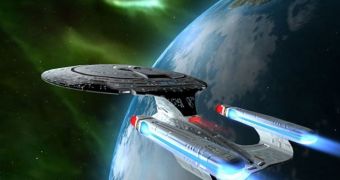So, is faster-than-light travel possible or not? Well, the Theory of Relativity does not inhibit such processes, at least not in the local sense of the problem. Warp drives represent a fictional propulsion system that would in fact enable us to move through the fabric of space-time at speeds faster than that of light. The first attempt to describe such a device was made by Miguel Alcubierre, in 1994, and presents a method to bend the space into a so-called warp bubble, in which a space ship would sit.
The ship would create a warp bubble, by contracting space in front of it, and expanding it behind. By doing so, the ship would be able to move along with the warp bubble through space at relativistic speeds, without suffering the effects associated with time dilatation, because the ship would basically be in a gravitational free fall. Although it might seem that the Alcubierre warp drive contradicts the Theory of Relativity, it actually does not. The ship would not exceed the speed of light in relation to the bubble, thus the persons inside it would not feel the inertial effects.
Why don't we build an Alcubierre warp drive and conquer the universe? We would if we knew how to do that, but so far there are no methods to create the warp bubble, thus the Alcubierre drive remains just a theoretical curiosity for now.
First of all, the creation of a warp bubble inside the universe would allow the Alcubierre warp drive to violate certain energy conditions and require exotic matter to exist. Even if exotic matter does exist, distributing it in space in order to create a warp bubble later is a questionable capability. According to Russian physicist Serghei Krasnikov, the time required to bend the space into a warp bubble would always be greater than the time necessary for a beam of light to travel the respective distance, resulting in a situation identical to that of a space ship traveling through space at speeds lower than that of light.
A second problem is that exotic matter violates the FTL travel principle and predicts the existence of tachyon particles required to create a naked singularity in front of the ship. The energy required to create warp bubbles is absolutely massive. In 1999, while continuing the work of Alcubierre, Chris Van Den Broeck realized that the energy required to transport only a few atoms through space, at speeds faster than that of light, would be equivalent to about three solar masses. Later on, Van Den Broeck, reduced the required amount of exotic matter to only a few milligrams, by slightly modifying the Krasnikov metric.
All we have to do now, is find ourselves some exotic matter!

 14 DAY TRIAL //
14 DAY TRIAL // 
